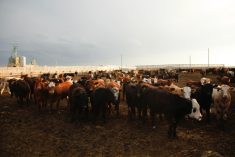Compared to last week, yearling prices were steady to as much as $4 lower depending on the region in Western Canada. Alberta packers were buying fed cattle at an average price of $252 on a dressed basis, down $6-$8 from last week and down about $20 from the last week of January.
Weakness in fed cattle prices quickly spilled over into the yearling market due to the negative margin structure. The U.S. Department of Agriculture’s WASDE report was also considered quite negative for heavier yearlings due to upward adjustments in first- and second-quarter beef production. Feedlot inventories in Alberta and Saskatchewan were 20 per cent above the five-year average as of Feb. 1; therefore, pen space is limited.
Read Also

U.S. grains: Wheat futures rise on supply snags in top-exporter Russia
U.S. wheat futures closed higher on Thursday on concerns over the limited availability of supplies for export in Russia, analysts said.
In central Alberta, red- and white-face medium-frame steers with heavier flesh levels weighing just over 900 lbs. were valued at $179; tan mixed steers coming from forage diet weighing 825 lbs. were valued at $183 delivered in southern Alberta. In Manitoba, Simmental-blended steers weighing just over 800 lbs. were quoted at $185. East of Saskatoon, mixed medium- to larger-frame black steers with light grain diet weighing 915 lbs. were quoted at $175. Yearling heifers were trading at a $15-$20 discount from values mentioned above. Feedlots had a tendency to focus on local cattle where they had a better idea of diets and pre-conditioning but the market was relatively even across the Prairies.
Mid-weight calves were relatively unchanged from last week while lighter calves and grassers traded $3 lower to as much as $5 higher. Strong demand was evident, from the small farmer/cattle producer to finishing feedlots. The 2019 Canadian calf crop may be lower than anticipated as the industry awaits Statistics Canada’s data at the end of the month — this coming on the heels of a year-over-year decline in the calf crop south of the border.
New-crop barley is trading in the range of $205-$210 in the Lethbridge area for September and lower input costs for the fall period are also driving the grasser market higher. Weather has been favourable for cattle movement and good-quality calves are coming on the market at this time of year. Discounts are minimal for adverse characteristics, with ownership the main goal.
In central Alberta, Charolais-blended steers averaging just over 520 lbs. were quoted at $254 while black steers weighing 545 lbs. were reported at $239. In central Saskatchewan, a feedlot operator reported medium- to larger-frame 610-lb. black steers were valued at $230 delivered. Calf prices in the eastern Prairie regions were quite variable, with some crowds lacking buying interest. Mixed steers in southern Manitoba weighing just over 650 lbs. were quoted at $208 while black steers weighing 700 lbs. were valued at $202. The heifer discount to steers on feeders between 500 and 600 lbs. was in the range of $18-$25.
— Jerry Klassen manages the Canadian office of Swiss-based grain trader GAP SA Grains and Produits Ltd. and is president and founder of Resilient Capital, specializing in proprietary commodity futures trading and market analysis. Jerry consults with feedlots on risk management and writes a weekly cattle market commentary. He can be reached at 204-504-8339 or via his website at ResilCapital.com.















